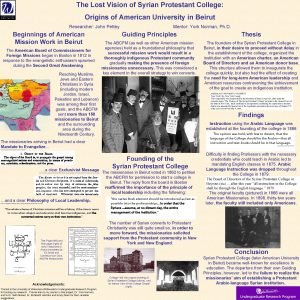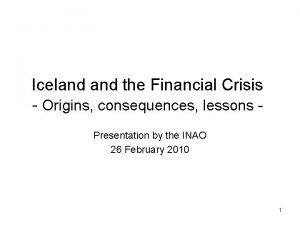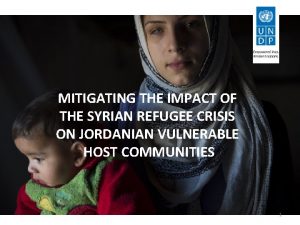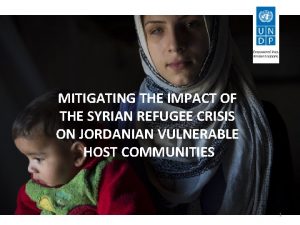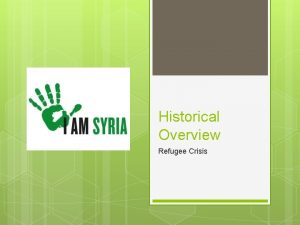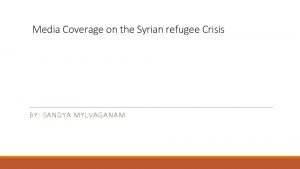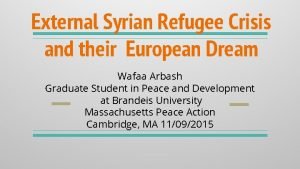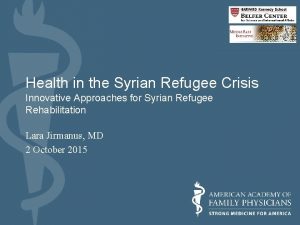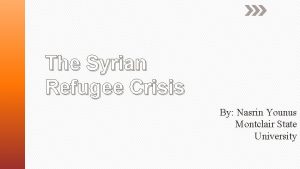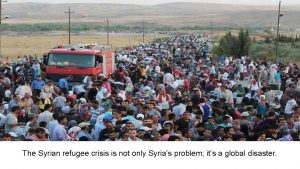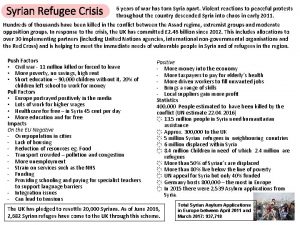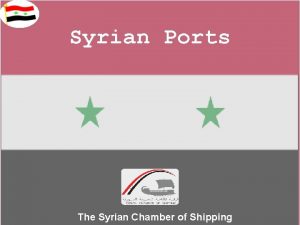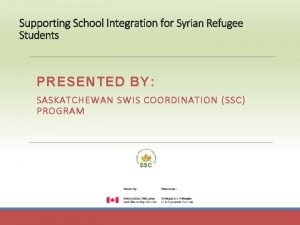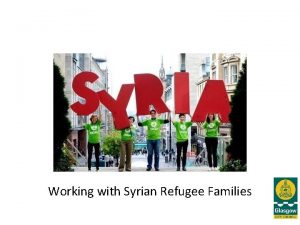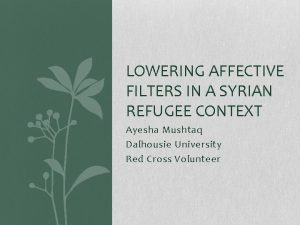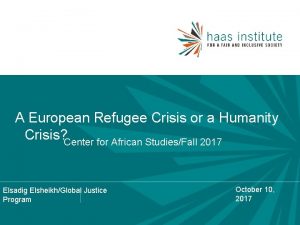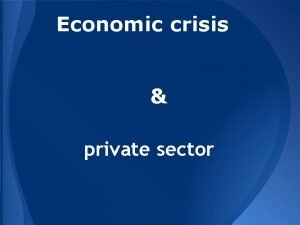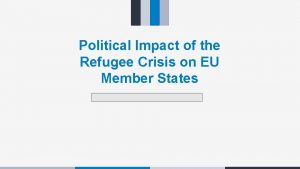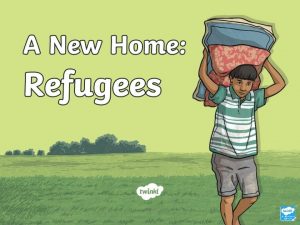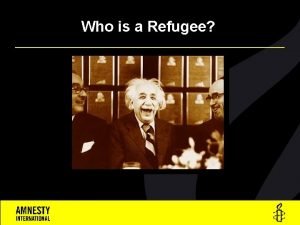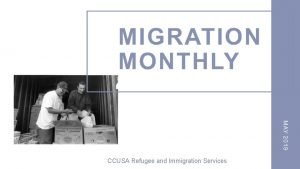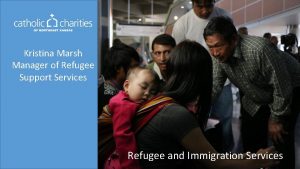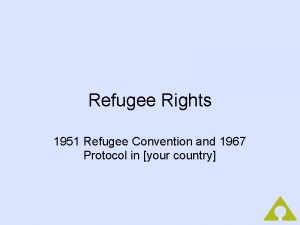Economic Impact of the Current Syrian Refugee Crisis



























- Slides: 27

Economic Impact of the Current Syrian Refugee Crisis: Separating the Myth from the Reality A Presentation Organized by the Center for Equality and Justice Picture taken from Mondoweiss (http: //mondoweiss. net ) and to be credited to UNHCR Jamshid Damooei, Ph. D Professor and Chair Department of Economics, Finance, and Accounting, School of Management

Content of the Presentation • Basic Information about the crisis, its size and escalation • Relative share of the “burden” as some would like to call it • Is this influx an economic threat for many of the hosts countries or a blessing? (separating the myth from the reality). • The short-term bottlenecks & the support needed to reduce or remove them • Conclusion and Possible Policy Implications

Profile of Syria ü Syria is located on the eastern end of the Mediterranean Sea, bordered by Turkey on the north, Israel and Lebanon on the west, Iraq on the east, and Jordan on the south. ü Syria has a history of religious tolerance and pluralism and is a much more secular society than many of its Muslim neighbors. ü Syria’s population is 90% Muslim (74% Sunni Muslim and 16% Alawite, Druze, and Ismaili). Christians form 10% of the population. ü Like many developing countries people in the rural areas have far less access to viable economic means, social services and medical care.

Profile of Syria ü By 2013, roughly half of the country’s health care facilities had been destroyed or damaged, and most of Syria’s health care professionals had fled or been killed or injured. More than 220, 000 have been killed and the number is rising. ü In pre-conflict Syria, free public education for all became a government goal. Post-secondary education was highly subsidized in an effort to meet the country’s development needs. ü In the early 1980 s, an estimated 42% of the population could not read or write. By the early 2000 s, Syria’s adult basic literacy rate had risen to over 90% for men and over 77% for women, according to the CIA World Factbook. ü In 2013, UNICEF reported that many schools had been severely damaged or were being used by armed groups and displaced persons seeking shelter. School attendance rates had plummeted—down to 6% in some areas.

Profile of Syria ü As of October 2014, the three-year conflict in Syria has displaced nearly 9. 5 million people, more than 40% of the country’s pre-war population. ü Of these, over 3 million have found temporary asylum in the neighboring countries of Lebanon, Turkey, Jordan, Iraq, and Egypt. About 6. 5 million are internally displaced. ü Only about 15% of the Syrian refugees live in refugee camps. The rest live outside camps, in cities, towns, and rural areas, often in difficult circumstances and in locations not easily reached by humanitarian aid organizations. ü The United Nations High Commissioner for Refugees (UNHCR) has asked resettlement countries to admit some of the refugees. As of October 2014, 24 countries, primarily in Europe and the Americas, have agreed to resettle Syrians.

Profile of Syria ü A Brief History: Syria was part of the Ottoman Empire for 400 years, from the early 1500 s to the early 1900 s. ü A period of French colonial rule (1918 -1946) ended with Syrian independence. ü The next 20 years saw multiple coups and a brief unity with Egypt as the United Arab Republic. ü In 1963, the Ba’ath party took over the government, installing a secular and socialist Arab regime. ü In 1970, the Minister of Defense, Hafez al-Assad, seized power, and in 1971 made himself president. He died in June of 2000. He ruled the country with an Iron fist despite its Sunni opposition. ü His son, who is by training a Medical Doctor, Bashar al-Assad took presidency after his father passed away and is currently the president of the country. He attended postgraduate studies at the Western Eye Hospital, in London, specializing in ophthalmology In 1994.

The Route From Syria to Europe Source: Buzzfeed News http: //www. buzzfeed. com/rossalynwarren/here-is-the-long-route-many-refugees-take-to-travel-fromsyr#. ym. RQoez 3 j

Demographic Characteristics of Syrian Refugees ü Overall, the Syrian refugee population is young for both males and females: 62 per cent are below the age of 24. (ILO Office in Lebanon) ü Most refugee families (56 per cent) are between four to six-member households, with 11 per cent of households comprising eight or more members. Central Bank of Republic of Turkey, 2015

Distribution of The Refugees Source: http: //www. migrationpolicycentre. eu/migrant-crisis-refugees/

Distribution of Asylum Seekers in Europe and Elsewhere Source: http: //www. migrationpolicycentre. eu/migrant-crisis-refugees/

Separating the Myth from the Reality Here are how some present this problem and their commitment: ü David Cameron’s (Prime Mister of U. K. ) used the phase “swarm of people” to describe refugees camped out in deplorable conditions at Calais. He said taking more refugees wasn’t the answer, bringing peace and stability to the Middle East is the solution. But the Prime Mister never offered what should happen while they are waiting for the peace to return. ü Most American politicians from both sides supported humanitarian efforts but US role in accepting refugees remains an unanswered question. Indeed one may say that there was plenty of lip service from the US side. ü CBS News in September 2015: “The United States has taken in 1, 500 Syrian refugees since the Syrian conflict began about four years ago, with roughly 1, 300 coming in this year. Another 300 are expected to be settled in the U. S. within the next few months. The U. S. has also provided more than $4 billion for humanitarian aid in Syria since the crisis began. ”

Separating the Myth from the Reality ü Here are some views taken from those with extreme views and opinions about the world and their fellow human beings (cleaned from their ugly racist comments): ü Our welfare state pays Christian and Jewish groups to bring the Muslim terrorists of tomorrow to our towns and cities. And their gratitude will be as short-lived as our budgets. ü Some people’s understanding of our budgetary obligations is far from reality when it comes to our war and peace efforts. Just for your information the cost of Iraq war per day was $720 million in the midst of the war in 2007. This figure breaks down into $280 million a day from Iraq war supplementary funding bills passed by Congress, plus $440 million daily incurred, but unpaid, long-term costs. Sep 22, 2007 (source: https: //www. nationalpriorities. org/campaigns/cost-wariraq/? gclid=CP 7 j 1 d 3 x 7 cg. CFQYIa. Qodeds. P 1 Q ) ü The head of a UNHCR camp called Syrian refugees "The most difficult refugees I've ever seen. In Sweden, they took off their clothes to protest that it was too cold. ü The crisis here is caused by the magnet of Western welfare states. Get rid of the magnet and you get rid of the crisis. ü Keeping the doors open intensifies the crisis. It’s the sympathy of the bleeding hearts that leads to dead children whose parents are willing to risk their lives for their own economic goals.

Separating the Myth from the Reality: The ongoing cost of war Source: Time, http: //time. com/3651697/afghanistan-war-cost/

Possible Economic Impacts on Host Countries • No doubt that the extreme views do not represent the views of the majority of Americans or Europeans, who are caring, descent and believe in the universal high moral views of humanitarian treatment of children and families in such catastrophic conditions. • However, when the information are not shared and discussed publically, people may find themselves confused and thus they may indirectly contribute to a common belief based on the false information. • Some elements of the extreme views may have found their place in the minds of a significant majority in the Europe or the US, when people do not have a chance to examine the existing data and are led by what they hear. • These are often in areas of economic burden of refugees and the so called “fact” that they are and will taking our jobs and misusing our welfare system. • The following data is to prove that then reality/truth cannot be any further from what these views present: Separating the Myth from the Reality.

Is Accepting Refugees an Economic Burden? The Basic Demographic and Economic Information for Selected Countries: Countries Ratio of Children (under 14) to Seniors (65 and above), 2014 Dependency Ratio (2015) Unemployment Rate Budget Deficit Total Population (2014) as % of GDP (2015) Ratio of Foreign Born Over Total Population (2010) Size of Workforce (2014) Annual Population Growth (2015) GDP Growth (2014) Turkey 3. 59 49. 7% 9. 9% -2. 4% 79, 414, 269 1. 9% 27, 560, 000 1. 26% 2. 9% Lebanon 3. 81 47. 3% 6. 5% -9. 8% 6, 184, 701 17. 9% 2, 481, 000 0. 86% 2. 3% Jordan 9. 06 64. 8% 11. 9% -4. 3% 8, 117, 564 49. 2% 1, 959, 000 0. 83% 3. 1% Greece 0. 68 56. 2% 26. 5% -3. 4% 10, 775, 643 10. 0% 3, 910, 000 -0. 01% 0. 8% Macedonia 1. 37 41. 4% 28. 5% -4. 0% 2, 096, 015 6. 3% 961, 400 0. 20% 3. 8% Serbia 0. 84 50. 1% 19. 7% -6. 9% 7, 176, 794 7. 2% 2, 818, 000 -0. 46% -1. 8% Hungary 0. 81 47. 9% 7. 8% -3. 0% 9, 897, 541 3. 7% 4, 388, 000 -0. 22% 3. 6% Austria 0. 74 49. 2% 5. 6% -2. 4% 8, 665, 550 15. 6% 3, 860, 000 0. 55% 0. 3% Germany 0. 60 51. 8% 5. 0% 0. 4% 80, 854, 408 13. 2% 42, 650, 000 -0. 17% 1. 6% USA 1. 28 50. 9% 6. 2% -2. 8% 321, 368, 864 13. 8% 156, 000 0. 78% 2. 4% Australia 1. 16 50. 9% 6. 1% -1. 9% 22, 751, 014 21. 1% 12, 370, 000 1. 07% 2. 7% New Zeland 1. 36 54. 0% 5. 4% -0. 9% 4, 438, 393 22. 0% 2, 452, 000 0. 82% 3. 2% United Kingdom 0. 98 55. 1% 6. 2% -6. 0% 64, 088, 222 10. 4% 32, 620, 000 0. 54% 2. 6% France 1. 00 60. 3% 10. 2% -4. 3% 66, 553, 766 10. 3% 29, 870, 000 0. 43% 0. 4% Sweden 0. 89 59. 3% 7. 9% -2. 2% 9, 801, 616 13. 9% 5, 124, 000 0. 80% 2. 1% Sources: 1 2 3 4 5 6 7 8 9 Ratio of Children and Old Age, https: //www. cia. gov/library/publications/the-world-factbook/fields/2010. html#tu Dependency Ratio - CIA Workbook, https: //www. cia. gov/library/publications/the-world-factbook/fields/2261. html#tu Unemployment Rate - CIA Workbook, https: //www. cia. gov/library/publications/the-world-factbook/fields/2129. html#tu Budget Deficit - CIA Workbook, https: //www. cia. gov/library/publications/the-world-factbook/fields/2222. html#tu Total Population - CIA Workbook, https: //www. cia. gov/library/publications/the-world-factbook/fields/2119. html#tu Foreighn Born Population - Trading Economics, http: //www. tradingeconomics. com/france/international-migrant-stock-total-wb-data. html Size of Workforce, CIA Workbook, https: //www. cia. gov/library/publications/the-world-factbook/fields/2095. html#tu Annual Population Growth - CIA Workbook, https: //www. cia. gov/library/publications/the-world-factbook/fields/2002. html#tu GDP Growth - CIA Workbook, https: //www. cia. gov/library/publications/the-world-factbook/fields/2003. html#tu

Is Accepting Refugees an Economic Burden?

Is Accepting Refugees an Economic Burden?

Is Accepting Refugees an Economic Burden?

Is Accepting Refugees an Economic Burden?

Is Accepting Refugees an Economic Burden?

Is Accepting Refugees an Economic Burden?

Is Accepting Refugees an Economic Burden? The Short Term Cost:

Is Accepting Refugees an Economic Burden? Let us look further: ü Germany figures each refugee will cost $14, 000 a year to feed, house, teach and pay a monthly stipend. ü But this does not have to be the case: ü Let the refugees work. The country may well make that money back, largely because Syrian refugees tend to be skilled and young. ü Only 0. 5 percent of all asylum requests processed in Germany within the first six months of this year were approved. Every third applicant received a so-called "Tolerance, " and was therefore allowed to remain in Germany for the time being (source: http: //www. dw. com/en/thebig-questions-germany-and-refugees/a-18615133. ü Two out of three Germans think that the issue of "refugees and asylum" is the most pressing political. Seventy-three percent of those polled said that Germany's asylum policy needed to be changed. ü One voice inviting in refugees is the head of Mercedes-Benz and chairman of Daimler, Dieter Zetsche. Over the weekend (September 8, 2015), Zetsche said in an interview that today’s refugees “are exactly the people we’re searching for. ” ü Giving people the opportunity to work is respecting their dignity, good for the host country, in almost all cases have no apparent short-term negative impact, does not cost the host country in budgetary expanses and have absolutely certain long-term benefit.

The Short-Term Bottlenecks & The Needed Support Economic affluence of countries and size of the problem in short term matter: • There are expenses for housing, processing and helping refugees to settle, no matter what the long-term benefits are. • Of the 4 million Syrians who’ve fled since their country’s civil war began in 2011, the vast majority have crowded into Jordan, Turkey, and Lebanon. • Jordan hosts more than 600, 000 refugees, who are sorely taxing housing markets and thirstily tapping the country’s rapidly declining water resource (Source: http: //fortune. com/2015/09/15/syria-refugees-europe/. • • Turkey’s refugee population has skyrocketed this year to almost 2 million. Tiny Lebanon: 1. 1 million Syrians have joined a preexisting population of over 400, 000 Palestinian asylum seekers. Today in Lebanon, roughly one in four people is a refugee. Jordan, Turkey, and Lebanon have a combined population of 86 million and a nominal GDP of roughly $900 billion. As a point of comparison, the EU has a population of 500 million and a GDP of $18. 4 trillion. USA has a population of a of 319 million and a GDP of $17. 4 trillion (current US prices in 2014). On whose shoulder is the burden, if we see ourselves as people of the same world and members of the same family?

Conclusion and Possible Policy Implications Some of the Possible Measures: ü Improve processing procedures in countries where most of them are at this time. The reason they are spreading is lack of attention to their plights by the world communities. One cannot keep a refugees for years in a camp with the hope of going to Germany or US. ü Provide substantial financial assistance for this temporary in between housing and other expenses. ü Counties need to accept a meaningful number of refuges based on their economic conditions. As we have shown the so called burden does not exist in long-term and can be reduced or eliminated if their integration is done in a timely manner. ü Give employment right in countries like Turkey, which is expected to be a full member of EU. There a number of studies that show the negative impact on Turkish labor market is doubtful.

Conclusion and Possible Policy Implications ü Saudi Arabia, the UAE, Kuwait and Qatar – have no justification to be stepping aside and not give their support. Their supports for various waring sides in the Syrian war is one of the reasons the conflict has lasted so long. ü End the war in the middle east by practical diplomatic solutions, which involve brining all sides of the conflict into the negotiations and find a coordinated solution that is acceptable to all patties. ü Make sure that possible unintended consequences of foreign policies do not result in destruction of states in various parts of the world. This can only be done through support of civil societies in various countries and creation of true (not manufactured) political consensus between all stakeholders in a region. ü Use means of economic development as an option as soon as conditions on the ground come back to normalcy and put a much greater emphasis on non-governmental organizations (both and for most domestically but also internationally as the capacity within countries are enhanced).

The End Thank you Time for Q & A
 Hamsters syrian
Hamsters syrian Syrian protestant college
Syrian protestant college Elisha and the syrian army
Elisha and the syrian army Myasthenia gravis sauna
Myasthenia gravis sauna Iceland economic crisis
Iceland economic crisis What is the scope and economic impact of agribusiness
What is the scope and economic impact of agribusiness When did pax romana begin
When did pax romana begin What is the scope and economic impact of agribusiness?
What is the scope and economic impact of agribusiness? Scope of agribusiness
Scope of agribusiness Social impact of pax romana
Social impact of pax romana Output sector in agribusiness
Output sector in agribusiness Positive impact of economic in tourism
Positive impact of economic in tourism What is diffusion current and drift current
What is diffusion current and drift current Diffusion current formula
Diffusion current formula Line vs phase voltage
Line vs phase voltage The value of vgs that makes id approximately zero is
The value of vgs that makes id approximately zero is Arc
Arc Ac systems lesson 4
Ac systems lesson 4 Energy band diagram of pn junction diode
Energy band diagram of pn junction diode Line current and phase current
Line current and phase current Hazard based safety engineering
Hazard based safety engineering Drift current and diffusion current
Drift current and diffusion current Infineon
Infineon Line current and phase current
Line current and phase current Non planar circuit
Non planar circuit Economic growth vs economic development
Economic growth vs economic development Economic growth vs economic development
Economic growth vs economic development Lesson 2 our economic choices
Lesson 2 our economic choices

